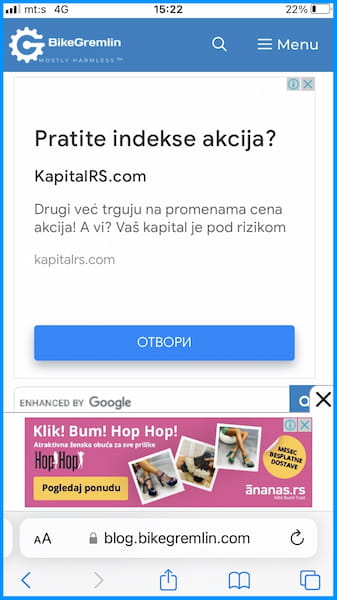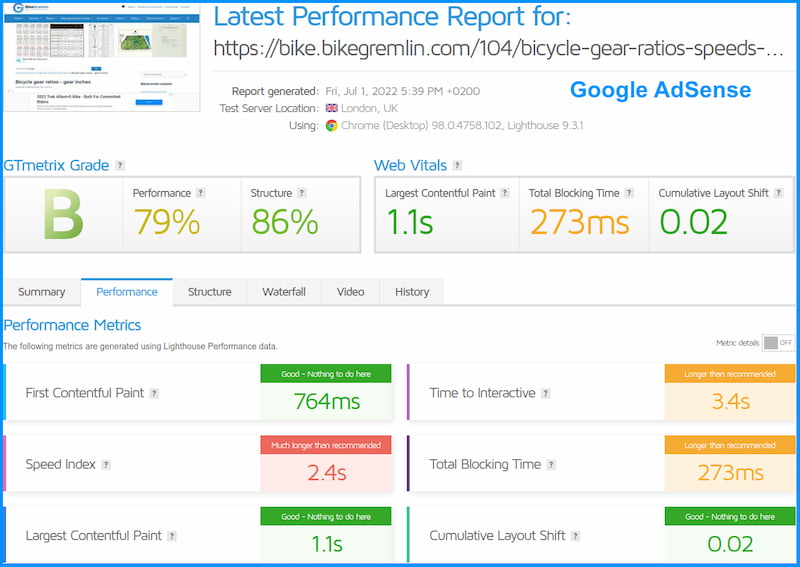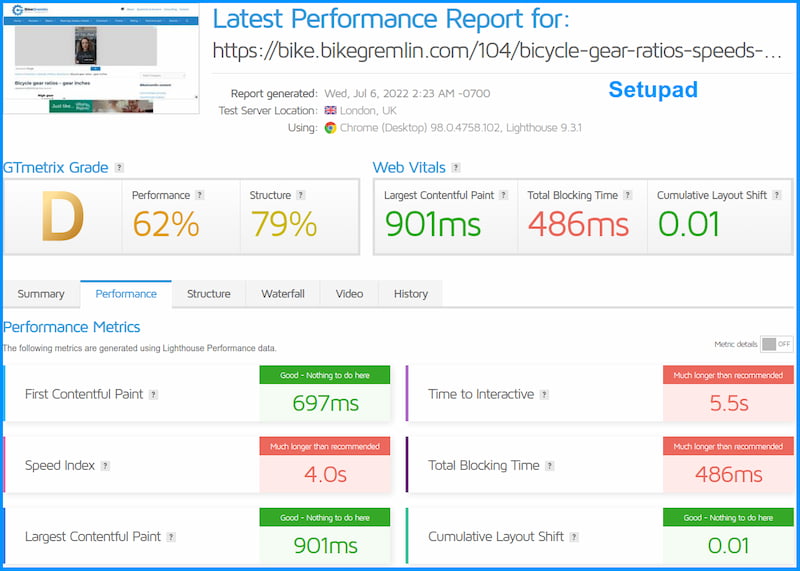Here, I’ll share my experience (some would call this “a review”) with the Setupad company (link to their website), which offers a website monetisation platform. I’ll compare it with Google AdSense, noting all the differences, pros and cons, and explaining the onboarding process.
If interested, you can read about my Google AdSense experience and other website monetisation options.
Note: I’ve tested this service for only about a week – so take all the pros and cons given here with a grain of salt.
Also, Setupad team is working on fixing all of the here-noted problems.
Status: Passive
I briefly tested this service during the summer of 2022
Table Of Contents (T.O.C.):
- The Setupad company info
- Setupad onboarding process
- Website advert implementation
- Performance impact (speed)
- Earnings $$$ 🙂
- Conclusion
1. The Setupad company info
Setupad is from Riga, Latvia. Googling company info says they were founded in 2015 (just like BikeGremlin! 🙂 ) Their “about us” page says Toms Panders is the co-founder and the CEO.
They offer an automated website monetisation service. Bluntly put: you specify where and what formats of ads you want to be shown on your site, insert Setupad’s code on your site, and voila! Adverts get shown.
Setupad worries about finding advertisers, charging them etc, and they take 21% of the profit. The rest is given to you. You get paid for advert views, not only for clicks like AdSense does. This policy has pros and cons, but that’s a topic for a separate article. I was curious to see if this hot new platform would make more money than AdSense.
2. Setupad onboarding process
Direct and simple. A Setupad Account Executive (let’s call them “Saule” for privacy reasons) sent me an email explaining what Setupad does and asking if I’d like to come onboard.
Unlike most offers I get on a daily basis, Saule knew my name, who I was, and had an idea of what my website was about. And I was led to expect a higher income than I got from AdSense. How could I refuse that?!

Picture 1
Jokes aside, unlike with most big corporations, here I was dealing with a person with a name and a face in charge of leading my account. So I’m not a client No 20389120, but a “Serbian idiot who fixes bikes” (joking 🙂 ). Very quickly, we arranged a video call to arrange all the details.
Saule created me an account. After that, I could use Setupad’s control panel to change my password and follow further instructions. Basically, I just had to add an ads.txt file to the root directory of my website/domain.
3. Website advert implementation
First, we discussed what kinds of adverts I want to be shown on my website(s). Just like Google’s AdSense, Saule encouraged me to use the popup ad format. I respectfully declined that, despite it being very profitable. I hate the annoying popups and don’t want to hassle anyone with them on my website(s).
We agreed to use the following ad formats:
- A large banner ad at the top of each page.
- A vertical side banner on desktop only (pretty neat they allow such automation 🙂 ).
- An anchor ad stuck to the bottom on desktop, and on the top on mobile (this last item got moved over a few times as I’ll explain below).
Then, I received the code I was to copy/paste into the WordPress widget area as a “Custom HTML” widget. That part was the same as with AdSense, if not even simpler (see how to implement AdSense to WordPress for details).
However, the implementation had a few hiccups at the start.
On mobile, the anchor banner is displayed right from the start, at the bottom. With the top banner, practically the entire screen was covered with adverts – not a pretty site for any visitors arriving:

Picture 2
With AdSense, the anchor ad is placed at the top on mobile – and it’s displayed only after a visitor has scrolled beyond the top banner ad.
Fortunately, I tested the implementation on my blog, which no one reads. 🙂
I notified Saule of this problem, and Saule notified Setupad developers.
To avoid messing up the code, I also asked for a minimum height for the top banner ad to be defined and set to 280 pixels (style=”min-height: 280px;”). This helps prevent CLS problems (link to web.dev site).
These things were solved within one working day. Very good.
Finally, I noticed a bunch of errors produced when running the Setupad code:

Picture 3
These errors don’t break the site, but I don’t like seeing them. AdSense doesn’t have such problems.
Saule has relayed my feedback to the developers, and we’re waiting for a fix. I’ll update the article when that’s resolved.
I noticed another interesting problem.
CLS (cumulative layout shift) on mobile was huge if you start scrolling down before the anchor ad gets loaded. If you don’t start scrolling, there’s no CLS. CLS tester tools missed this problem, and I realised it only after GSC (Google Search Console backend) complained about the user experience on mobile.
AdSense anchor ads never had this problem, even though they too load at the top on mobile. Hence, I asked Saule to see if we could have the anchor ad moved back to the bottom on mobile (reverting the previous change). Preferably having it start loading after a visitor starts scrolling down (not right from the start, so the whole page is covered in ads). Alternately, I could remove the top banner ads since the anchor ads create roughly four times more revenue based on my initial Setupad testing. The Setupad team edited the code swiftly, within a few hours.
For now, the problem with ads covering the entire starting page (picture 2) can be solved by removing the top-banner ad.
CLS can negatively impact website ranking and the number of visitors.
To me, this doesn’t look too good. Nonetheless, only people who don’t do any work never make mistakes. I decided to be patient and see if the problems would get resolved in a few weeks. I hope my feedback and testing have helped Setupad better optimise the ads for any future users. I also hope this article helps other content creators optimise their websites and know what to look out for.
4. Performance impact (speed)
Adverts load noticeably slower than AdSense ads. The “auction,” which provides for higher prices and more revenue, lasts a second longer. However, the ads are loaded asynchronously. In other words, your web page contents load and display normally for the visitors. The ads showing a bit later shouldn’t be a problem.
I’m mentioning this because if you use GTmetrix (link to their website) or similar tools, you’ll see the page load times increase by several seconds. Know that all the contents will not be loaded that much slower. It’s just the ads waiting to get loaded. Here are some speed-test results for comparison (the website’s hosting server is in the USA, and the testing was done from London):

Picture 4

Picture 5
Note that these are generic tests. I’ll get a realistic comparison when I see the average actual visitor page load speeds. Until then, I’m taking this with a bucket of salt.
I dislike that, even with an Ad-blocker (i.e. without loading any ads), Setupad’s code makes the site run slower than AdSense. Also, with an Ad-blocker, the 280 px high space for the top banner remains blank (reserved). AdSense doesn’t have this problem (even though I also set it to a pre-defined min. height of 280 pixels). With an Ad-blocker, AdSense ads are removed, along with their reserved space. See the screenshots below to see what I mean:

Picture 6
I implemented Setupad on July the 5th, 2022 and tracked the real-user performance results in Google Analytics and Google Search Console (GSC).
In less than a week, Google Search Console was filled with “CLS over 0.1” warnings for mobile and with slow LCP warnings (also for mobile).
Such things can negatively affect website ranking and the number of visitors. I felt a bit stupid for using live websites I’ve worked very hard for years on, to do beta-testing of a platform that doesn’t look to be production-ready. My decision, my websites, my fault.
I removed Setupad right away and put AdSense back. In less than 28 days, we’ll see if the problem is confirmed as fixed. Then I’ll know with more certainty if it was Setupad-related.
Update, August 2022:
Yes, all good now, so the problem was caused by Setupad.
5. Earnings $$$ 🙂
I started testing even though the console error problem (shown in picture 3) still wasn’t fixed. I noticed some more problems later (explained in chapters 3 and 4).
During the last few days of testing (before I decided to remove Setupad because of the GSC warnings), the revenue was roughly 50% to 100% higher than with Google AdSense!
It’s also fair to add: at the moment I stopped testing, revenue was still growing from day to day. I didn’t wait to see how high it could go.
In terms of revenue, I’d say that Setupad leaves AdSense in the dust. 🙂
Unfortunately, I had no patience to further test this on production websites. Staging websites, on the other hand, don’t have any real visitors, so they can’t be used for testing advertising platforms.
6. Conclusion
I’ve been using Google AdSense for years. Google is a behemoth and there I’m just a number. In case of any problems, I was left to, well, Google 🙂 for solutions and “talk” to robots. With Setupad, I talked with real people. My questions were quickly and clearly answered, and a lot of my feedback was quickly implemented.
In spite of that, unfortunately, the technical problems (speed, UX and UI) were the reason I decided to stop using the service.
Setupad has a great team of friendly and patient people. I hope my feedback has helped them more than it’s taken their time. I’m happy to continue beta-testing their platform on my blog. The problem is that blog has very few visitors (no sane person reads that 🙂 ), so it doesn’t provide any real-visitor performance data in the GSC. But I’m not willing to further “play” with the production sites. It seems too risky, despite the much better revenue.
In the meantime, I plan to test Cloudflare’s Pro and WordPress APO service (my review). After that, I’ll give Mediavine a try (another AdSense alternative – see my Mediavine review/experience). Unless I “land” a sponsor by then and ditch the automated ads altogether. 🙂
The problem with this last thing is there mustn’t be any conflict of interest, i.e. I don’t accept any publishing policy interference.

